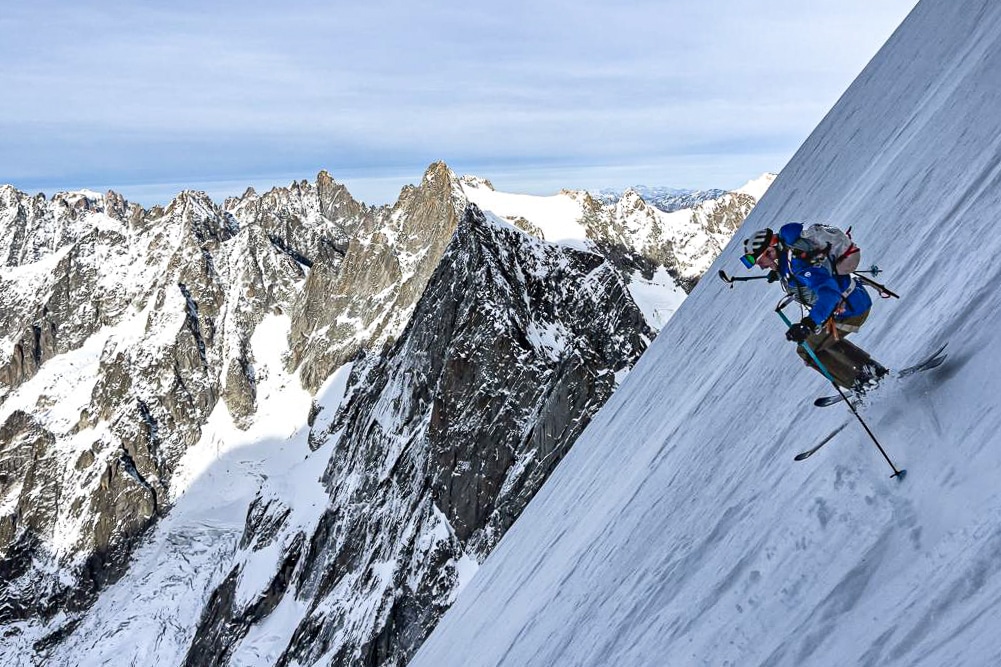He kicked off the 2022/2023 season with a historic descent of the Shroud on the north face of the Grandes Jorasses, France, with Boris Langenstein. He also put down his skis on Gasherbrum II in Pakistan. High-mountain guide Guillaume Pierrel is a passionate skier. He tells us about the three models of Plum ski bindings that accompany him throughout the season, with a focus on the Plum ski stops available with Plum Oazo and Pika bindings.
Boom ! He kicked off his ski touring with one of the most exposed descents in the Mont-Blanc massif, namely the Linceul on the north face of the Grandes Jorasses. For Guillaume Pierrel, it’s the fruit of a month spent examining the face from La Flégère. But above all, it’s the fruit of his already long experience of mountain skiing, at high altitude and on steep slopes, as well as in competition, with the support of Plum ski bindings, which equip all his pairs of skis. “I use three Plum bindings depending on my needs. I use the R99, Plum’s 99-gram-per-foot binding (198 g per pair) on my competition skis, with a 65mm leg. I like dry uphill races, and these are also my bindings for regular ski-mountaineering training,” explains Guillaume Pierrel, who had a taste of the Pierra Menta in 2018.
“The R99 is perfect for those races like the Millet Ski Touring Courchevel or the Avaline Tracks in Val d’Isère,” he adds. Good to know, the Plum Race R99 has a front release equal to 7, non-adjustable, it also offers the possibility of choosing the side release equal to 6 or 8 depending on the direction of mounting of the heel piece, all with high-performance materials (Aluminum 7075).
And to ski the Linceul on the north face of the Jorasses? Guillaume Pierrel chose the Plum R150: “It’s the binding I use a lot for mountain and steep skiing. These bindings are mounted on my Zag Adret 78s, on Ubac 89s and even up to 95mm on the skate with Ubac 95s. The R150 (150 g per foot) is a super-sleek, super-simple binding with a wedge. You don’t even need to turn the heel piece. I had these bindings on my skis at Les Jorasses, but also on our descent of Gasherbrum II, on Adret prototypes.”
Note that the R150 is also available with a 40 mm adjustable rear base: a great solution for those who want to alternate between light boots (shorter) and higher-performance downhill boots (longer), or simply for those who, when fitting new skis, know they’ll have to change boots during the life of the ski – and therefore potentially sole length. Guillaume also uses this rear base as a wider base to compensate for the ski’s torsional stresses. With the optional 40 mm base (and 35 g per foot), Plum R150 bindings can be adapted to your needs.
I use the R150 a lot for mountain skiing, on my personal projects.
On a daily basis, Guillaume Pierrel also uses a third Plum binding: the Plum Oazo. Ultra-light without neglecting safety and comfort, the Oazo binding is the very essence of ski touring according to Plum. In terms of safety, it features adjustable side release (DIN 4-10), and fixed front release at 4, 6 or 8 depending on the model. At just 205 g per foot, the Oazo binding boasts a host of features: 3 wedge heights (0- 41-54 mm); a 25 mm adjustment rail (approx. 3 sizes); a removable knife holder compatible with all Plum knives.
Plum Ski Brakes
Last but not least: Plum bindings offer optional ski brakes, notably for the Oazo and Pika (and for the Summit too). Guillaume explains: “I use the Oazo on Ubac 89 slopes and off-piste, in teaching, and as a guide. Above all, I have the new ski brakes for the Oazo: only 65 g. more, and no more worries: as a pro, when you find yourself looking for your ski in the wild, you look stupid! So on the Oazo, I’ve got ski brakes, which are superbly finished. They’re an indispensable option for skiing and working when, like me, you can’t stand leashes!
Ski brakes or leashes, Guillaume has made his choice: “Leashes are a hassle and a lot of handling, so I ask my customers not to use them. When I’m in hyper-light mode (with the R150s), I block the front stops to go down steep slopes, and even elsewhere. It’s a choice. Otherwise, with the Oazo I use the ski brakes, and the problem’s solved.”
Tips
Any tips on how to get your bindings right before descending? “On steep slopes I’m methodical. You make the transition from crampons to skis. I start by cleaning the bindings, removing any ice under the front stop spring with the tip of a stick. Then I play with the stop closure – before putting on my skis, of course. I keep the upstream crampon, remove the downstream crampon, then put on the first ski, holding it outstretched between the tip and the binding; then I make a few back-and-forth movements, then snap the heel piece. Then I check once again that the front binding is locked”.
And if you’re not planning to ski the north face of Les Jorasses, Guillaume Pierrel has illustrated himself on the networks with a ski-in ski-out Moonwalk inspired by Mickaël Jackson: “Bindings in the up position, wedge at the back, everything happens at hip level, Mickaël Jackson in your ears! All you have to do is find the right wiggle!









